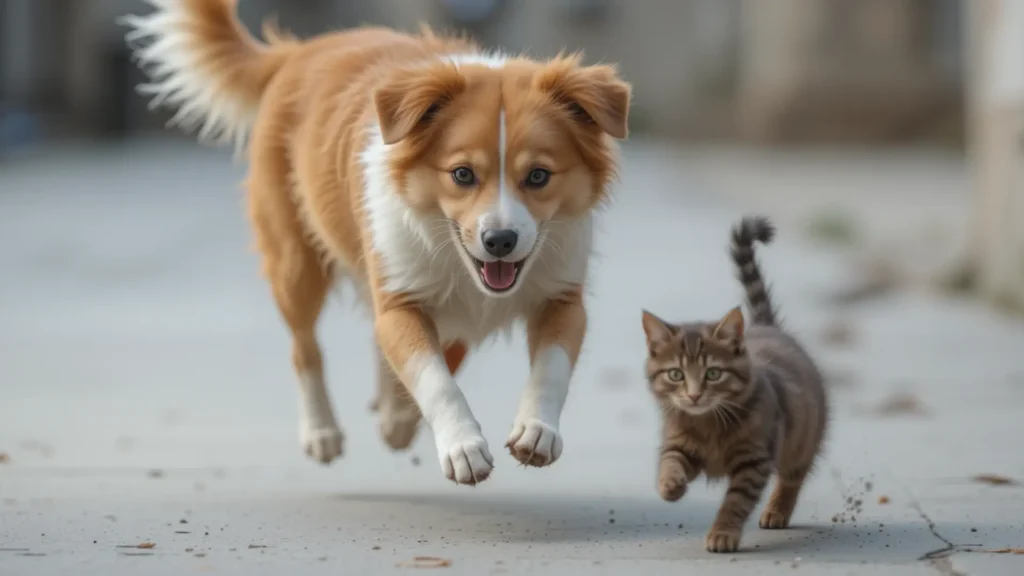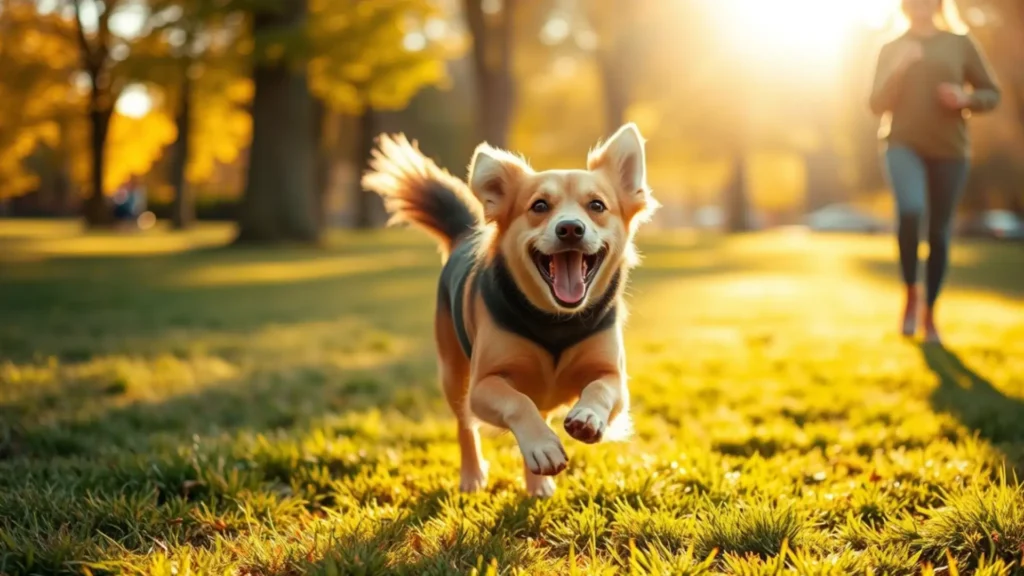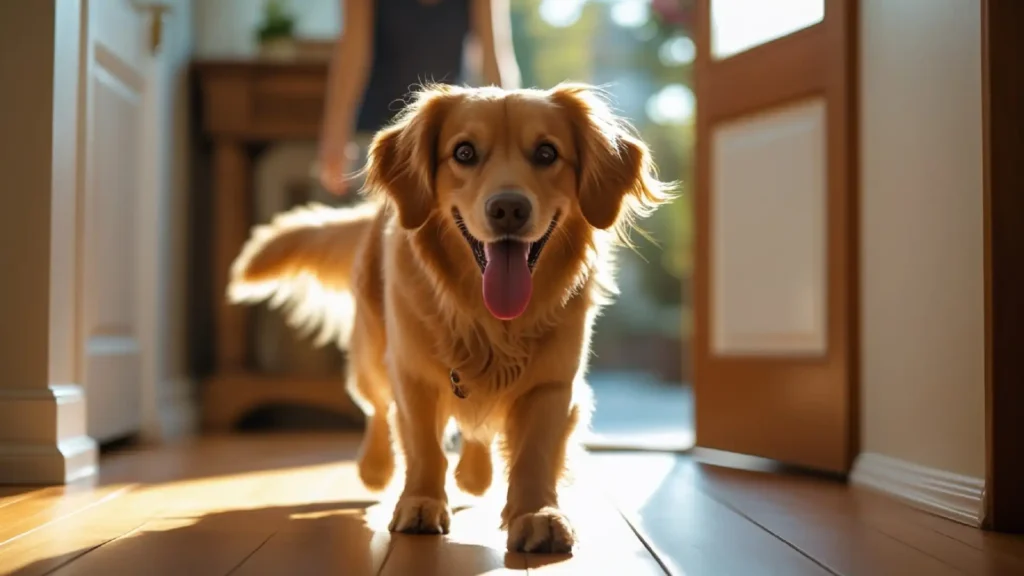Your dog sees a cat. Boom. It’s gone. Tail high, eyes locked, sprinting without thinking.
You yell. You run. You pray. But it’s too late. The chase is on. And your heart drops every time.
This isn’t just annoying. It’s dangerous. For your dog. For the cat. For people nearby. And it can destroy peace in your home or neighborhood.
Let’s fix that today.
You’re about to learn how to stop your dog from chasing cats—step-by-step, from the inside out.
No guesswork. No shouting. No tools you don’t need. Just solid, simple training from a pro who’s done this for years.
Why Dogs Chase Cats
If you don’t understand what’s driving the chase, you’ll never stop it.
Chasing is not random. It’s based on instinct. Movement triggers something inside dogs. It wakes up a part of their brain that says: “Go!”
Some breeds feel that stronger. Herding dogs, terriers, and hounds—those dogs are wired to chase. But any dog can develop this habit.
Chasing gives a thrill. It makes dogs feel alive. That’s why yelling doesn’t stop it. The fun is stronger than your voice.
Some dogs also chase cats out of fear, tension, or past experience. If a dog had a rough time with a cat before, it may treat every cat as a threat.
Other dogs see it as a game. The cat runs, so they run too. That game becomes a pattern. That pattern becomes a problem.
You need to break the pattern. But not with punishment. That won’t solve it. It may make it worse.
Steps to Stop Dog Chasing Cats
To stop your dog from chasing, you need to make calm behavior more rewarding than the chase. That takes training. Not guesswork.
Step One: Control the Space Before the Dog Controls the Chase
Before you can fix the chasing, you have to stop the practice runs. Every chase strengthens the habit. Every chase makes it harder to stop. You must stop the behavior first—then retrain your dog’s brain.
If your dog is free to roam the backyard without you watching, that’s a problem. Even if you have a high fence, don’t trust it yet. A cat could sneak in. Your dog could dig under. Or worse—learn that the yard is their hunting ground. That’s the last thing you want.
From now on, leash your dog every time it goes outside. Yes, every time. No matter how short the walk. No matter how calm the dog seems. You need full control during this stage.
If you absolutely must use a backyard, stand outside with your dog the whole time. Watch closely. Be ready to step in. Your goal right now is no chasing. Not once.
Inside the house, if you have both a dog and a cat, you need physical barriers. Baby gates. Crates. Doors. Use them. This is not mean. It’s smart. Dogs and cats must not share space until your dog is calm, focused, and trained.
Some dogs love cats. Others don’t. But during training, love doesn’t matter. Control does.
Letting your dog freely interact with the cat right now is a mistake. It creates too many chances for things to go wrong. The dog might chase. The cat might run. The pattern repeats. The habit grows.
You have to break the habit before you build the new one. That’s how behavior change works.
You’re not punishing your dog. You’re giving them structure. You’re giving them a chance to learn. You’re removing the old reward (the chase) and preparing them for the new one (praise and treats for calm focus).
This means:
- No unsupervised outdoor time.
- No loose access to cats.
- No chances to chase.
This won’t last forever. It’s a reset phase. A clean slate.
Every moment your dog is not chasing is a win. Those wins build the foundation for what comes next.
The leash is your friend. The crate is your tool. The gate is your helper. You’re not being strict. You’re being a real trainer.
And now, with space under control, it’s time to start teaching your dog what to do instead of chasing.
Step Two: Teach Calm Focus in the Face of a Cat
Now we’re ready to start the change. This step teaches your dog how to stay calm when they see a cat. No lunging. No barking. No running. Just peace and focus.
But don’t rush it. The trick is to start before your dog gets excited. If your dog is pulling or barking, you’re too close. Go back. Create more space. You want to train while your dog’s brain is still calm.
This isn’t just training. This is rewiring your dog’s brain. And timing matters.
Here’s what to do:
Get your dog on a leash. Pick a spot where a cat is visible, but far away. Not moving fast. Not running. Just there.
Now get out the good stuff. Not boring treats. Use high-value rewards. Tiny bits of chicken, soft cheese, or anything your dog truly loves. Make sure the treats are small so you can give lots of them.
The moment your dog notices the cat but doesn’t bark or pull, say “Yes!” and give a treat right away. Don’t wait. Don’t guess. Be quick. You’re catching the moment of calm and rewarding it.
This teaches your dog:
See a cat + stay calm = treat party.
That’s the lesson. You’ll repeat it again and again. Some dogs get it fast. Others take time. Doesn’t matter. Stay with it.
If your dog does bark or lunge? Don’t yell. Don’t pull back. Just calmly turn and walk away. Put space between your dog and the cat.
This sends a clear message:
Act wild = game over. Calm = reward.
Once your dog is calm again, you can try again—from a distance. This is training, not punishment. You’re helping your dog succeed.
Soon, your dog will start looking at you when it sees a cat. That’s gold. That’s the moment everything changes. Reward that fast. You’re building a habit of checking in with you.
Keep each session short. Five to ten minutes is enough. Don’t wait for your dog to mess up. End on a win.
With time and practice, your dog will learn a new rule:
Cats are not for chasing. Cats mean rewards come from my human.
This step does more than stop a problem. It builds trust. It teaches self-control. It makes your dog think.
And once your dog is thinking instead of reacting, chasing starts to fade. Not from fear. But from learning.
That’s the breakthrough. And it sets the stage for the next step—where we teach real-life obedience that sticks in every situation.
Step Three: Practice the Right Skills Before You Need Them
Now you need to teach your dog some backup skills. Tools you can use in real life.
First skill: the recall. That’s when your dog comes when called—fast and happy.
You want this rock-solid. Start indoors with zero distractions. Say “Come!” in a happy tone. When your dog comes, reward big. Treat, praise, play.
Then do it outside. Still on leash. Then on a long line. Then around distractions—but not around cats yet.
Build that recall until your dog runs to you like it’s the best part of the day.
Second skill: the “leave it” command.
This means: “Back off and look away.”
Hold a treat in your closed hand. Let your dog sniff, paw, lick. Don’t say anything. The moment your dog pulls away, say “Yes!” and give a treat from the other hand.
Repeat until your dog learns: “Backing off = reward.”
Then add the word: “Leave it.”
Now use toys. Food on the floor. Practice around moving things. Practice until your dog responds fast.
These skills give you real tools when cats appear. You won’t panic. You’ll have a plan.
Step Four: Controlled Setups That Build New Habits
Now you’re ready for the big test: real exposure, real control, real change.
Find a friend who has a calm cat. Use a leash, treats, and a plan.
Start far. Dog on leash. Cat in sight. Reward calm.
Move slowly. Inch by inch. If your dog pulls, go back.
Ask your dog to sit. Reward it for staying. Ask for eye contact. Reward that too.
Use your “leave it.” Use your “come.” Make it a training session, not a showdown.
Keep sessions short. End before the dog loses focus.
Repeat daily if you can. Build layers of success. That’s how habits form.
If your dog growls or shakes, pause training. Fear must be addressed with care. You may need help from a pro trainer in that case.
But for most dogs, this step creates a shift. They start to see the cat as part of life—not a trigger.
They stop lunging. They start thinking. That’s progress. That’s power.
Final Step: Live the Calm, Keep the Control
Once the chasing is gone, your job isn’t over. You need to maintain it.
Never trust your dog off leash near cats—no matter how trained. It’s not worth the risk.
Always be ready to reward calm. Carry treats. Use praise. Reinforce what you want.
Watch for stress. If your dog gets anxious or alert, add distance. Stay ahead of problems.
Give your dog daily exercise. Mental games. Clear structure. This keeps energy stable.
And if you slip? If your dog chases again? Don’t panic. Just reset. Go back to training. Keep control.
This is not about being perfect. It’s about being consistent.
You now know how to teach your dog a new way to live around cats. And that’s a win.
Your dog doesn’t have to chase cats forever. That habit can end. That stress can stop.
Now you know why dogs chase. You know how to break the habit. You know the skills that stop the sprint.
This is not magic. This is training. It works. It lasts. And it brings peace.
You’re not just stopping a problem. You’re building trust. You’re building control.
And your dog? It’s learning something powerful:
Stay calm. Stay focused. Stay with you.
That’s how you win the real chase. And you just did.




